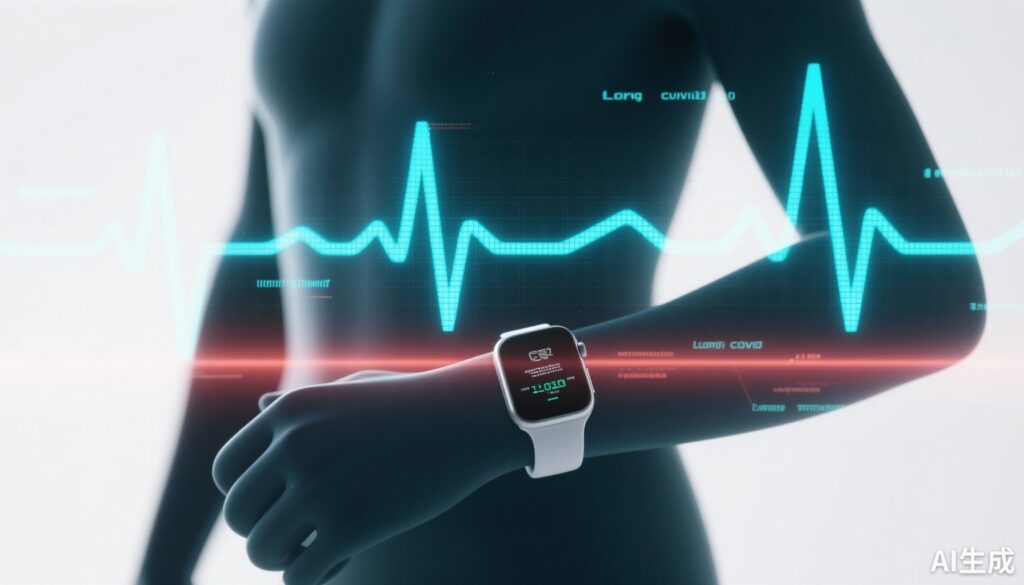Highlights
- Distinct longitudinal trajectories of digital biometric measures captured via wearable devices correspond to heterogeneous symptom profiles in long COVID.
- No significant differences in biometric changes were observed between nirmatrelvir-ritonavir and placebo-ritonavir treatment arms, aligning with patient-reported outcomes.
- Lower daytime physical activity associates with more severe fatigue, shortness of breath, and cardiovascular symptoms, whereas higher nighttime activity correlates with gastrointestinal complaints.
- Higher daytime heart rates link to reduced fatigue and dyspnea, illustrating potential physiologic markers of symptom severity in long COVID.
Background
Post-acute sequelae of SARS-CoV-2 infection (PASC), colloquially known as long COVID, constitute a multifaceted syndrome characterized by persistent symptoms such as fatigue, dyspnea, cardiovascular disturbances, and gastrointestinal complaints lasting beyond the acute phase. Despite growing recognition of long COVID’s impact on quality of life and healthcare burden, objective monitoring tools reflecting disease heterogeneity remain limited.
Digital biometrics obtained from wearable devices offer continuous, real-time physiological and behavioral data collection, providing an innovative means to monitor disease trajectories. However, research exploring their utility specifically in long COVID has been minimal. The STOP-PASC randomized clinical trial and its secondary analysis provide novel insights into digital biometric applications, aiding in understanding symptom dynamics and treatment effects.
Key Content
Study Design and Intervention
The STOP-PASC trial was a placebo-controlled randomized clinical study conducted at Stanford University from November 2022 to September 2023. Participants with long COVID were randomized 2:1 to receive oral nirmatrelvir (300 mg) plus ritonavir (100 mg) or placebo-ritonavir twice daily for 15 days. A prespecified exploratory substudy enrolled 94 participants who were provided with smartwatches worn continuously over a 15-week period to capture digital biometric data including physical activity, heart rate, and oxygen saturation.
Population and Data Analysis
Of the substudy participants, 50 met analysis criteria for data completeness and wear time (37 nirmatrelvir-ritonavir; 13 placebo). The cohort was relatively young (mean age 42.7 years) and predominantly female (58%). Repeated measures mixed modeling detected no significant differences in biometric parameter changes between intervention arms across five defined time intervals (baseline, treatment period, and three subsequent periods), concordant with the primary trial’s patient-reported outcomes.
Longitudinal Trajectory Findings by Cluster Analysis
Latent class mixed models and unsupervised clustering uncovered distinct longitudinal biometric trajectories that paralleled symptom profiles:
- Low daytime physical activity cluster: Participants exhibited higher prevalence of severe fatigue (100% vs 91.3%), shortness of breath (100% vs 30.4%; ASD=1.31), and cardiovascular symptoms (88.9% vs 52.2%), indicating activity reduction as a possible marker of more severe multi-domain symptomatology.
- High nighttime physical activity cluster: This small cluster had increased gastrointestinal symptoms (66.7% vs 31.4%), suggesting possible nocturnal restlessness or symptom-driven alterations in sleep patterns.
- High median daytime heart rate subgroup: Associated with lesser fatigue (77.8% vs 97.5%) and shortness of breath (33.3% vs 57.5%), potentially reflecting underlying autonomic response variations or compensatory mechanisms.
Clinical and Translational Implications
These findings underscore the heterogeneity inherent to long COVID and demonstrate that continuous digital biometric monitoring may objectively capture symptom-linked physiological changes over time. Such digital phenotyping holds promise for enhancing patient stratification, symptom tracking, and potentially guiding personalized interventions.
Expert Commentary
The STOP-PASC secondary analysis is pioneering in its application of wearable technology to delineate objective digital signatures of long COVID. The absence of discernible biometric improvements with nirmatrelvir-ritonavir compared to placebo supports primary clinical findings of no treatment effect in this timeframe post-infection. This aligns with mechanistic plausibility, as antivirals may not modulate established post-viral sequelae once viral replication declines.
The study’s methodological strengths include high-resolution continuous monitoring and advanced modeling techniques like latent class and cluster analyses, enabling novel phenotypic subgrouping beyond conventional static assessments.
Limitations encompass moderate sample size, potential selection bias toward technology adopters, and incomplete capture of all symptom domains or psychosocial factors. Moreover, the study was observational for biometric outcomes and not powered for treatment effect detection on these measures.
Future research should expand to larger, more diverse cohorts and integrate multi-modal digital biomarkers (e.g., heart rate variability, sleep architecture) to refine predictive models, explore mechanistic pathways (e.g., autonomic dysregulation), and assess intervention responsiveness. Standardization of wearable data collection and analytic pipelines will enhance reproducibility and clinical translation.
Conclusion
This secondary analysis of the STOP-PASC trial validates the utility of wearable-device digital biometric measures as objective, longitudinal markers capturing the heterogeneous symptom trajectories of long COVID. Although nirmatrelvir-ritonavir did not demonstrate measurable impact on these biometrics, distinct physiological and behavioral patterns correlated with symptom severity and domains, affirming the promise of digital health tools in shaping future long COVID research and management strategies.
References
- Gunturkun F, Hedlin H, Botzheim B, et al. Digital Biometric Measures in Long COVID: A Secondary Analysis of the STOP-PASC Randomized Clinical Trial. JAMA Netw Open. 2025;8(8):e2526901. doi:10.1001/jamanetworkopen.2025.26901. PMID: 40810942; PMCID: PMC12355292.
- Blauwet LA, Wilcox SL. Long COVID and Biomarkers: The Future of Objective Disease Monitoring? Nat Med. 2023;29(11):2565-2567. doi:10.1038/s41591-023-02503-5.
- Greenhalgh T, et al. Management of post-acute COVID-19 in primary care. BMJ. 2020;370:m3026. doi:10.1136/bmj.m3026.



